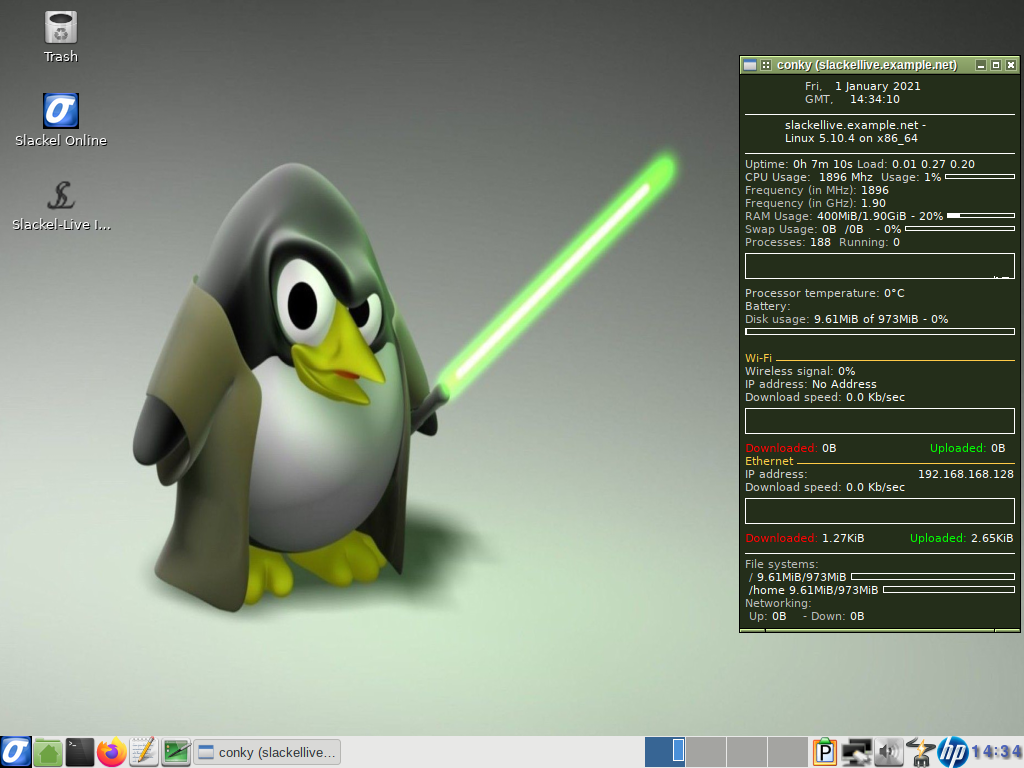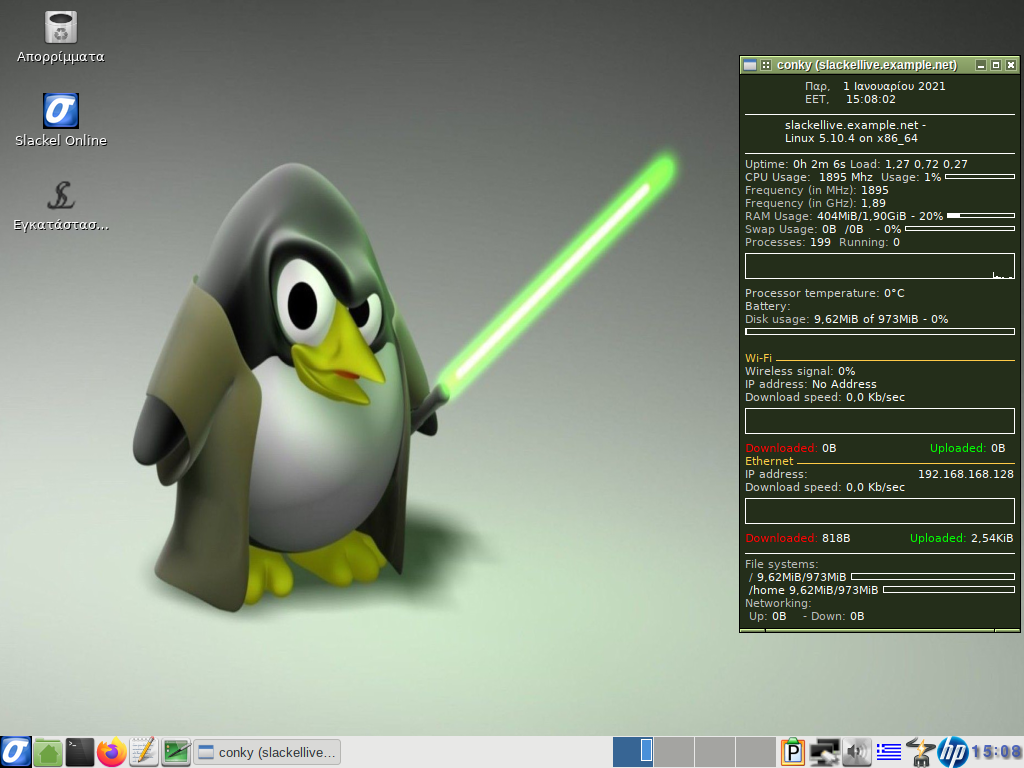Includes the Linux kernel 5.10.4 and latest updates from Slackware's 'Current' tree.
The new version is available in 64-bit and 32-bit builds.
The 64-bit iso image support booting on UEFI systems.
Iso images are isohybrid.
Iso images can be used as installation media.
It is good to read the Slackel Startup Guide before install Slackel.
What is new:
Slackel can be installed (real installation) in an external 16 or 32 GB usb stick or ssd disk and have a portable fast system always with you. You can upgrade it also having the latest programs. It is a real installation. You will not notice you run slackel from a usb. System is fast.
In details:
Slackel Live Installer (SLI) now can do a real installation to an usb stick or external usb ssd or external usb hard disk, creating the necessary initrd for booting.
For this a) create a msdos partition table on /dev/sdb or /dev/sdc and a linux ext4 partition on /dev/sdb1 or on /dev/sdc1 where /dev/sdb is your first usb device, /dev/sdc the second usb plug in device. Sign the /dev/sdb1 or /dev/sdc1 bootable.
Create also a linux swap partition to /dev/sdb2 or /dev/sdc2, with size 2 or 4 GB according the memory you have.
Or b)
1. Create a gpt partition table on /dev/sdb or /dev/sdc and fat32 500MB partition on /dev/sdb1 or on /dev/sdc1 where /dev/sdb is your first usb device, /dev/sdc the second usb plug in device. Sign the /dev/sdb1 or /dev/sdc1 boot,esp.
2. Create a linux ext4 partition on dev/sdb2 or /dev/sdc2
3. Create also a linux swap partition to /dev/sdb3 or /dev/sdc3, with size 2 or 4 GB according the memory you have.
4. Create a fat32 33MB partition on /dev/sdb4 or /dev/sdc4 and sign it bios_grub
If you boot using a slackel live openbox dvd then your external usb device will be recognized as /dev/sdb.
If you boot using a slackel live openbox usb then the second usb you will use for real installation it will be recognized as /dev/sdc.
Persistent become slow after installing programs. Doing a real installation on an usb stick or external ssd disk you will have a portable slackel usb in your pocket. You will even notice you run from a usb. It is fast. It is a really portable installed system which can be upgraded. To upgrade the kernel you have to use the install-upgrade-kernel-ext-usb script so usb will be bootable. (e.g. sudo install-upgrade-kernel-ext-usb upgrade huge)
To boot from ext usb or ssd plug in your usb reboot and press fn+F12 (in my case for lenovo laptop) and from bios boot menu choose the usb to boot.
Some of the packages included in iso:
mozilla-firefox-84.0.1, mozilla-thunderbird-78.6.0, libreoffice-7.0.4.2, filezilla-3.51.0,smplayer-20.6.0, gimp-2.10.22 (you have to install multimedia codecs from menus to use exaile to play mp3 files), fbpanel is used, many gui applications for managing the system and more.
USB Installation (frugal install)
If you want to transfer the iso to a USB stick, make sure you read the respective instructions in this file:
http://www.slackel.gr/isos/slackel-live ... ON_USB.TXT
You can also use the instonusb gui tool to transfer the iso to a usb.
Windows users can use the rufus application which exists in iso in boot folder to transfer the iso to a USB stick under windows system. Be sure to name the usb label "LIVE" without quotes.
Persistent file encryption is also supported.
medialabel="USB_LABEL_NAME" parameter.
Users who use a different program to create the live USB and this name the usb label differently than the default which is "LIVE" and/or also want to have many distributions on usb, can pass the parameter medialabel="YOUR_USB_LABEL_NAME". In this case slackel will be found and can boot.
Note: Install the iso in the usb without persistent (because it will take a lot of time) Then run again the script to create the persistence file.
sudo sh install_on_usb.sh --usb path_to_iso_image device
sudo sh install_on_usb.sh --persistent 64 /dev/sdb
(where device is /dev/sdb, /dev/sdc etc)
(The root password for the live CD is “live”. Standard user login is “one” with password: "one") (no quotation marks).
For installation and for all work required administration privileges the super user "one" with password "one" is used.
Minimum system requirements:
* Pentium 2 or equivalent
* 512 MB (RAM) or 1024 (RAM) and more for libreoffice, firefox and other heavy applications.
* 10 GB HDD
You can download Slackel 7.4 Openbox iso image from the following links, using the Sourceforge servers.
Live iso images: Can be used also to install the system to hard disk.
Slackel64 7.4 "Live Openbox" (64-bit)
(size: 2062 MB, md5: 5832b7a0a6057d87b4fa3ec7e9603585 sha1: 40cd006d9bd08dc5241ca5c8620722a08ba0e127)
Sourceforge: https://sourceforge.net/projects/slacke ... o/download
pkglist
Slackel 7.4 "Live Openbox" (32-bit)
(size: 2082 MB, md5: 9fc9633eecfd118157c5a0cd43f21cde sha1: 4aa288b0c21c25d7c9ebfa56c5e0359fddf9ce82)
Sourceforge: https://sourceforge.net/projects/slacke ... o/download
pkglist
Have a Happy and Healthy New Year 2021
Dimitris Tzemos
screenshots

